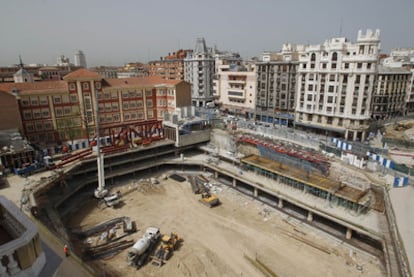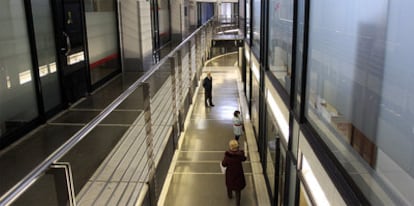Madrid's markets take a beating
A lack of funding has seen several refurbishment projects put on hold
L ike most of Spain's principal cities, Madrid has been on a spending spree for the last 15 years, accumulating massive debts in the process. When the financial crisis hit in 2008, and Spain's banks could no longer borrow on the international markets, Madrid found itself unable to pay back what it owed. The capital now has debts of more than 750 million euros, around 1,000 euros per inhabitant - or more than a quarter of all money owed by Spanish cities.
Matters have been helped by the Plan E infrastructure program, funded by the central government, which in 2009 invested 8 billion euros in local projects. But this year sees the end of Plan E, and town halls will be forced to settle up their accounts.
Last year the government signed an agreement with the Spanish Federation of Municipalities and Provinces (FEMP) to reduce their budget deficits from 0.5 percent of GDP to 0.2 percent by 2013. In the meantime, dozens of projects have been put on hold, among them three of the capital's most emblematic markets.
"They say that they'll have finished it within a year. But I can't see it myself," says Jesús, a veteran stallholder at Madrid's Barceló market, which serves the capital's trendy Chueca neighborhood. He's been selling fruit from a temporary site next to the old market since December 2009, when the original Barceló market, which dates back to 1950, was demolished. He's not happy at the prospect of another year of having to make do. "It's a disgrace. In the old market I had 27 square meters - but here I've got just 10."
Jesús' fears of an extended stay in his temporary premises are justified by a walk round the corner to the site of the new market. There is no sign of any construction other than a hole in the ground where a four-story underground car park will go. City Hall said in 2009 that the 43-million-euro market would be finished by this spring; then it said by the end of the year; now it is saying that it will be completed by June 2012.
But the 104 traders reveal that City Hall has already admitted that the earliest the market will be finished is December 2012. The stallholders have lost money: they agreed to use the temporary market instead of demanding compensation. But what was going to be a stay of less than two years will end up being three-and-a-half years - if they're lucky.
And it's not just the market folk who have been inconvenienced. The 360 pupils of the adjoining Isabel la Católica junior school will have to spend another year as guests of the nearby San Mateo school, where they have been since the beginning of 2010. The school hoped to take advantage of the building work on the new market to carry out major refurbishments. These have now been finished, but teachers and parents say that there is no question of returning to the school while work continues next door. "The children and staff will not be able to study and work properly with so much noise and dust," says Maribel Fuentes, the head of the school's parent-teacher association. "What's more, we can only use one of the school's yards, which is very small," she adds.
When, and if, the new Barceló market is ever finished, it will consist of two buildings: the market and a sports center, and a library, which is due to be built on to the Isabel la Católica school. The market, covering 7,150 square meters over three floors, will consist of an elevated gallery connected by moving stairways up to a terrace that will lead into an upper gallery. All deliveries, garbage collection, storage space, refrigeration areas, and staff parking will be located in the underground car park, avoiding further congestion in the narrow surrounding streets.
The temporary market was designed by Spanish architects Nieto & Sobejano. It consists of six interconnected irregular hexagons, and is made of white polycarbonate.
"If they don't hurry up, they will have put us all out of business," says greengrocer Alberto Mate. He says that his turnover has been cut in half since he has been in the temporary market. Like other traders, he complains that he hasn't enough space to display his goods properly. "In the old market I had around 15 square meters, but here, with less than five meters, I can't do much." He points to a photograph of his old pitch on the wall.
"Before, my stall could be accessed from three streets, and the customers could see me better. But what with the through traffic having stopped, because of the building work, a lot of people don't bother to come by any more." Mate says that he has already had to lay off one of his employees; even so, he says that he can barely make ends meet. He was recently fined 1,300 euros by the health inspectors for not having a refrigerator to store prepared salads. "Look," he gestures angrily at the tight space he works in. "How on earth am I supposed to fit a refrigerator in here?" He says he will appeal against the fine.
"I can't wait to get out of here," he says, running through the problems that he and his customers have had to put up with in the temporary market: water leaks, flooding, slippery floors that have caused several accidents, faulty air conditioning, a lift that keeps breaking down... Other traders tell the same story, some noting that the waste pipes are not wide enough and regularly get blocked.
"This temporary market has been designed very badly - it just doesn't work properly," says Rafael Montes, the head of the local traders' association. "It looks nice, but it is no use whatsoever as a market. The architects won a prize with it, which is great for them..."


The ghostly shopping mall
The Puerta de Toledo shopping mall was built in the 1980s with the aim of reviving a once-run-down area in the center of the capital. City Hall attracted a range of up-market businesses to the five-story circular building, located on the site of the city's former fish market. Today, most have moved on, and less than 20 small businesses remain.
The site is managed by the regional government of Madrid, although it is owned by City Hall. In January, the regional government signed an agreement with the privately run Carlos III University to convert the building into a post-graduate campus. But shopkeepers in the center say they are being kept in the dark. Many accuse City Hall of failing to maintain the center properly so that they will leave.
"What is most worrying about the announcement regarding the Carlos III University is that our customers will think that we have closed," says Sabin Orueta, who, along with his wife, has run a hair salon in the mall for more than 15 years. He says that the Puerta de Toledo has been in decline since the late 1980s.
"They have cut back on security staff and cleaners, as well as reducing the air conditioning and heating, and even the music that used to be played," says Orueta. City Hall admits that it has been reducing the running costs of the center ahead of its plans to change its purpose. "I can't even afford to pay the taxes on my business," he says.
According to Orueta, when the center first opened, its shops - including trendy fashion chain Adolfo Domínguez and home-furnishings outlet La Oca - attracted the rich and famous. "You would see Bruce Springsteen or Cher here buying shoes, you'd see architects... it was spectacular," he says. As one of the longest-standing leaseholders, he has been told he can stay until his contract expires in 2016. But he can't see the point. City Hall says it wants to reach an agreement with the few remaining shopkeepers in the center. "We will negotiate on a case-by-case basis. If anybody wants to stay until 2016, there will be floors that can be used for commercial purposes, while the other floors are adapted to the use of the university," says a regional-government spokesman.
Orueta traces the long, slow decline of the Puerta de Toledo mall back to 1997, when City Hall changed the legal status of the building - presumably with a view to giving it a different use. The deal signed in January clearly states that it would be "incompatible" to mix retail with education.
That said, City Hall has continued to rent out premises to retailers up until January of this year. The council says it has continued to do so until it found a "solution to the problem."
But the Puerta de Toledo's days are now finally numbered. City Hall is trying to persuade shopkeepers to leave as soon as possible. Adolfo Domínguez, which occupies the entire fifth floor, will close in August.
Tu suscripción se está usando en otro dispositivo
¿Quieres añadir otro usuario a tu suscripción?
Si continúas leyendo en este dispositivo, no se podrá leer en el otro.
FlechaTu suscripción se está usando en otro dispositivo y solo puedes acceder a EL PAÍS desde un dispositivo a la vez.
Si quieres compartir tu cuenta, cambia tu suscripción a la modalidad Premium, así podrás añadir otro usuario. Cada uno accederá con su propia cuenta de email, lo que os permitirá personalizar vuestra experiencia en EL PAÍS.
¿Tienes una suscripción de empresa? Accede aquí para contratar más cuentas.
En el caso de no saber quién está usando tu cuenta, te recomendamos cambiar tu contraseña aquí.
Si decides continuar compartiendo tu cuenta, este mensaje se mostrará en tu dispositivo y en el de la otra persona que está usando tu cuenta de forma indefinida, afectando a tu experiencia de lectura. Puedes consultar aquí los términos y condiciones de la suscripción digital.








































